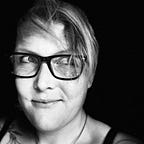Legacy and Longing : The Importance of Being Remembered
A story of coleslaw, heartache and leaving your mark.
The coleslaw my Grandma Betty made was the taste of my childhood. Aggressively blended and heavy on the vinegar, I can pinpoint so many memories of her that are anchored by this coleslaw. In fact, when I think of my grandmother, dead more than 25 years, I remember a cacophony of things, but always end with coleslaw.
She had Marlene Dietrich legs, but was a diabetic so always had issues with them. She taught me how to blow eggs and we would paint and decorate them together; and would delight if she managed to find a blue duck egg to use. She used to boil eggs by wrapping them in foil and sticking them in a cup of water in the microwave (don’t try this at home). And she loved me unconditionally.
But this story is not really about my Grandma.
The Construct of Legacy
We are surrounded, and perhaps burdened, by legacy from the get-go. Carrying a family name, being named after relatives, building chains of tangible links to our past and future through family.
We are remembered by our children, as we remember our parents and grandparents. Stories and family traditions passed down through the generations.
Or for those without a family past to draw from, a future is forged in defiance or in desperation. Legacy is built from the ground up.
But what is left of legacy if we don’t or can’t have children?
The Tale of Some Insolent Ovaries
I was told at 19 that I couldn’t have children. An asthma attack and a massive dose of steroids as an early teen had caused early menopause. My ovaries were shrivelled up and useless.
At 19, I don’t think I understood what the true consequences were of this revelation. The truths of such a brutal diagnosis revealed themselves to me across the decades. Not in a linear way, but in a series of realisations that evolve as you grow as a person; and as your landscape changes.
The lack of choice was a particular burden on me. I wasn’t choosing not to have children, that decision was taken from me. When I signed up to do IVF — the poking, prodding and constant pressure to lose weight — made it seem so much less romantic than in stories. When I received the call to say we had made it to the top of the IVF list a few days after my husband and I had broken up, I was suddenly relieved at my insolent ovaries.
But this story is not really about my ovaries.
A New Way to Leave a Legacy
When you trace your family tree back through generations, sometimes you get lucky and find lots of information — newspaper articles, army records, tangible evidence of not just the person, but their life.
And sometimes you get super lucky and find living relatives who are able to bring that person to life through stories and tales and lived experiences.
I spent my twenties with a nagging concern that if I was to die that minute, there would be no trace of me. Without children, who would speak of me once I was gone.
Looking back with withering hindsight, I can see now that many of my decisions were based on that nagging fear of being forgotten. I wrote songs that chronicled my journey as a person, I performed and saved the newspaper reviews; and I produced album after album. Tangible evidence of my existence.
The Irony of Deaccession
What resulted from my healthy desire to leave a mark was an achievement-based gratification system. I was hungry to achieve, to collect the milestones, and to try things simply to say I had.
One of these achievements was a Masters in Museum Studies. During this course we studied deaccession — the process in which a museum will remove items in their collection in order to either make physical room or financial space for new items.
I found myself profoundly hurt by the process of deaccession, despite understanding rationally the reasons for it.
Then it clicked. The strides I had taken, the collections I was in, and mark I was trying to leave… it could all be taken away so easily.
Ironically, as I was writing this, I went looking into a library collection that once held my first CD (as an example of New Zealand music released in the 2000s), and could find no trace of it.
Let us Return to the Coleslaw
Every time I make Grandma Betty’s coleslaw, she lives on. She would laugh heartily at that notion, I imagine.
The decades have rolled on and I have reframed my ideas about legacy. From a longing that was hard to withstand, I have emerged hopeful. Buoyed by the possibility that my mark is not necessarily something that spans the ages; but instead is just this. Words on paper that remember others.
Perhaps my legacy will be borne by my penchant for whimsical Medium articles. Who knows?
Grandma Betty’s Coleslaw Recipe
- 1/2 green cabbage
- 1/2 a white onion
- Add 1/2 a carrot if you are feeling sassy
- 1/2 cup of white vinegar
- 2 tablespoons of white sugar
- Salt and pepper to taste
Blitz veggies in the food processor. Combine dressing ingredients and stir until sugar is dissolved. Adjust to your taste — combine and enjoy!
